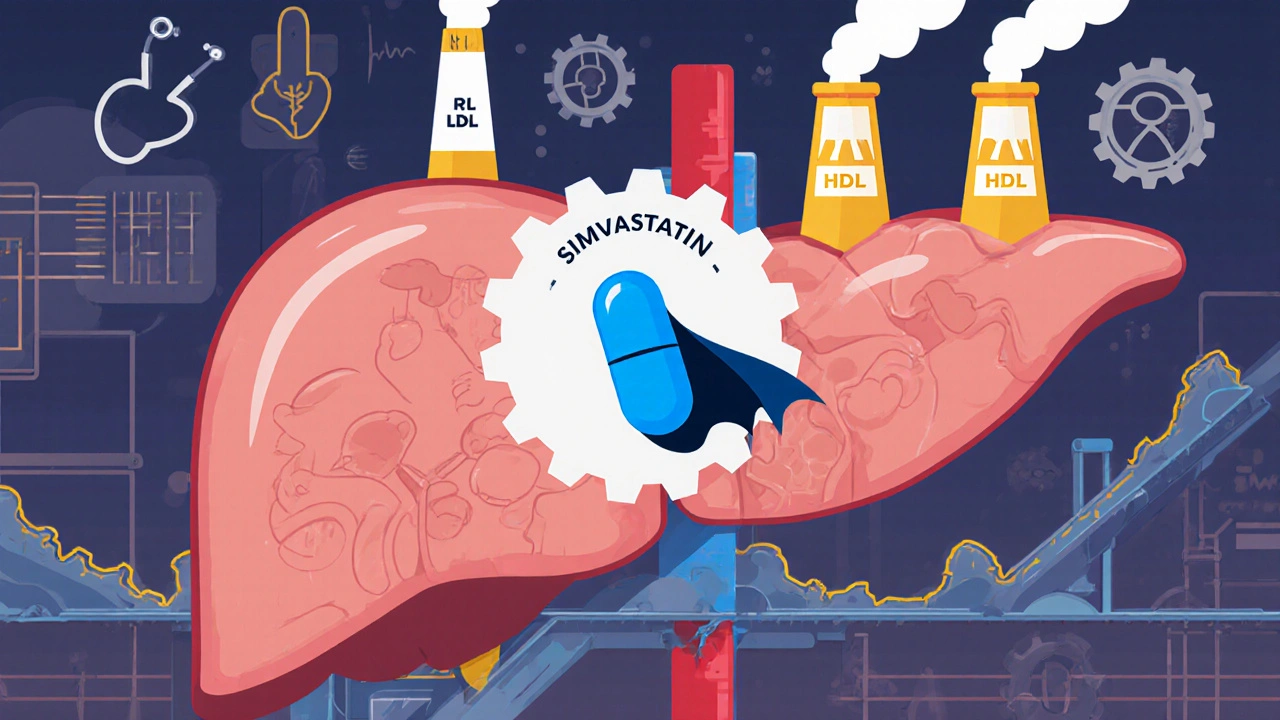Every year, heart disease snatches more than 17 million lives worldwide - a staggering reminder that managing cholesterol isn’t just a doctor’s concern, it’s a daily reality for millions of people.
When it comes to lowering that risky cholesterol a waxy substance that builds up in arteries and can lead to blockages, Simvastatin is one of the most widely prescribed tools in the arsenal. In this guide we’ll break down what Simvastatin a synthetic statin drug that inhibits HMG‑CoA reductase, the enzyme responsible for cholesterol production in the liver does, who benefits most, and how to use it safely.
What Is Simvastatin?
Simvastatin was first approved by the U.S. Food and Drug Administration (FDA) in 1991 and belongs to the statin class of lipid‑lowering medications. It’s a generic drug, meaning it’s available at a fraction of the price of brand‑name counterparts while delivering the same cholesterol‑cutting power.
How Simvastatin Lowers Cholesterol
Statins, including Simvastatin, target the liver’s cholesterol factory. By blocking the enzyme HMG‑CoA reductase, the liver produces less LDL cholesterol the ‘bad’ cholesterol that carries cholesterol to the walls of arteries and more HDL cholesterol the ‘good’ cholesterol that helps remove excess cholesterol from the bloodstream. Typical dose ranges (10‑80 mg per day) can shave 20‑55% off LDL levels within 4-6 weeks.
Clinical Benefits: Reducing Heart Attack and Stroke Risk
Large‑scale trials like the 4S and HPS studies showed that Simvastatin users saw a 20‑30% drop in major cardiovascular events. In plain terms, for every 100 high‑risk patients taking Simvastatin for five years, about 20‑30 serious heart attacks or strokes are prevented.
These benefits extend beyond just cholesterol numbers. By stabilising plaque and reducing inflammation, Simvastatin helps keep arteries flexible, lowering the chance of sudden blockage.

Safety Profile and Common Side Effects
Most people tolerate Simvastatin well, but a few need to watch out for muscle aches, mild digestive upset, or elevated liver enzymes markers like ALT and AST that signal liver stress. Serious muscle damage (rhabdomyolysis) is rare-about 1 case per 10,000 users-but it’s crucial to report any unexplained soreness, especially if you’re taking drugs that interact with Simvastatin.
Because Simvastatin is metabolised by the CYP3A4 pathway, grapefruit juice and certain antibiotics can raise drug levels, increasing side‑effect risk. Your clinician will check for such interactions before prescribing.
Who Should Consider Simvastatin?
- Adults with LDL cholesterol ≥ 130 mg/dL and a 10‑year cardiovascular risk ≥ 10%.
- People with a history of heart attack, stroke, or peripheral artery disease.
- Those with familial hypercholesterolaemia (a genetic condition causing very high LDL).
- Patients who prefer a proven, cost‑effective option over newer, pricier agents.
If you’re pregnant, breastfeeding, or have active liver disease, Simvastatin isn’t recommended. Always let your doctor know about existing conditions.
How to Take Simvastatin Correctly
- Take the tablet in the evening. Cholesterol production peaks at night, so an overnight dose works best.
- Swallow whole with a glass of water-do not crush or chew.
- Stick to the same time each day to maintain steady blood levels.
- Follow up with blood tests after 4‑6 weeks to see how LDL is responding.
- If dosage needs adjustment, your doctor may switch to a different statin or recommend a higher dose.

Comparing Simvastatin with Other Statins
| Statin | Typical Dose Range | Average LDL Reduction | Cost (UK, per month) |
|---|---|---|---|
| Simvastatin | 10‑80 mg | 20‑55 % | £5‑£12 |
| Atorvastatin | 10‑80 mg | 30‑60 % | £8‑£15 |
| Rosuvastatin | 5‑40 mg | 35‑65 % | £12‑£20 |
All three drugs belong to the statins a class of medications that lower cholesterol by inhibiting HMG‑CoA reductase, but Simvastatin remains a go‑to for many because of its balance of efficacy and affordability.
Quick Checklist: Is Simvastatin Right for You?
- Do you have elevated LDL or a high 10‑year heart risk?
- Is your liver function normal (ALT/AST < 3× upper limit)?
- Are you free of strong CYP3A4‑interacting drugs?
- Can you commit to an evening dose and periodic blood tests?
If you answered ‘yes’ to most of these, Simvastatin could be a strong ally in your cholesterol‑control plan.
Frequently Asked Questions
How long does it take for Simvastatin to lower LDL?
Most patients see a measurable drop within 2‑4 weeks, with the full effect stabilising around 6‑8 weeks.
Can I take Simvastatin with other cholesterol drugs?
Combining statins with other lipid‑lowering agents like ezetimibe is common and can boost LDL reduction, but always do it under medical supervision.
What should I do if I experience muscle pain?
Stop the medication and contact your doctor. They may lower the dose, switch to a different statin, or run a creatine kinase (CK) test to rule out serious muscle injury.
Is Simvastatin safe for people over 75?
Studies suggest starting at the lowest dose (10 mg) and monitoring liver enzymes closely. The benefit‑risk balance remains positive for many seniors with high cardiovascular risk.
Can lifestyle changes replace Simvastatin?
Diet, exercise, and weight loss can lower LDL by 5‑15%, but they rarely achieve the 30‑50% reduction that a statin provides for high‑risk patients. Often a combined approach works best.


Lionel du Plessis
October 25, 2025 AT 17:49Statins like Simva are the workhorse of lipid therapy
Andrae Powel
November 4, 2025 AT 00:02It’s crucial to pair Simvastatin with regular liver function panels, especially in the first few months. Keeping an eye on CK levels can catch rare muscle issues early. Also, don’t forget lifestyle tweaks – diet and exercise still boost the drug’s effect.
Jennie Smith
November 13, 2025 AT 06:16Totally agree, the synergy between a solid diet and Simva can feel like a turbo‑charged engine for your arteries. Imagine your LDL as traffic jammed cars; the statin clears the highway while the veggies act as traffic lights directing flow. Consistency is key – taking the dose at night aligns with hepatic cholesterol synthesis peaks. If you skip a night, you might see a small rebound, but getting back on schedule fixes it fast. Some patients even report a newfound “energy” when the plaque stabilises. So, think of it as a team sport: the drug, your meals, and your moves all score the win.
Anurag Ranjan
November 22, 2025 AT 12:29Start low – 10 mg at bedtime – and titrate only after the 6‑week lipid check.
James Doyle
December 1, 2025 AT 18:42There is a moral imperative embedded in every prescription of Simvastatin, a reminder that we as a society have chosen to prioritize profit over the collective well‑being of the cardiovascular populace. The pharmaceutical giants, cloaked in glossy advertising, parade the drug’s LDL‑lowering capabilities while conveniently downplaying the specter of myopathy that haunts a subset of patients. When clinicians hand out Simvastatin without thorough discussion of dosage titration, they are complicit in a system that normalizes chronic medication dependence. The data from the 4S and HPS trials, while impressive, were funded by entities with a vested interest in market expansion, thereby casting a lingering shadow over the purity of the findings. Moreover, the reliance on CYP3A4 metabolism creates a minefield of drug–drug interactions that the average patient, awash in the deluge of polypharmacy, cannot navigate unaided. Grapefruit juice, a seemingly innocuous breakfast companion, becomes a lethal ally when paired with Simvastatin, amplifying plasma concentrations to dangerous levels. This pharmacokinetic nuance is often relegated to footnotes in patient information leaflets, consumed only by the diligent few. In the broader context, the emphasis on a single statin overlooks emerging lipid‑lowering modalities that may offer superior safety profiles. Yet, the inertia of clinical habit persists, bolstered by insurance formularies that reward the cheapest generics over innovative therapies. Each missed opportunity to personalize therapy is a silent concession to the status quo, a tacit endorsement of the “one‑size‑fits‑all” paradigm. The ethical quandary deepens when considering adherence: patients burdened by side effects frequently self‑discontinue, only to present later with catastrophic cardiovascular events that could have been prevented. In that moment, the blame is misdirected onto the patient, while the root cause-an overly aggressive, one‑dose‑fits‑all approach-remains unexamined. Therefore, the prescription of Simvastatin should be accompanied by rigorous shared decision‑making, transparent discussion of risks, and a willingness to explore alternatives when indications are marginal. Only through such conscientious practice can we hope to realign the balance between pharmaceutical profit motives and the genuine health interests of the public.